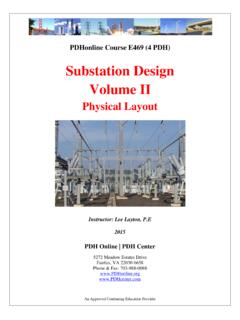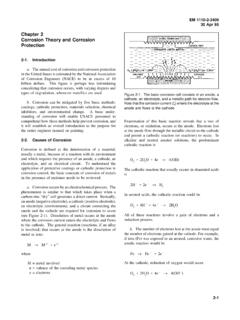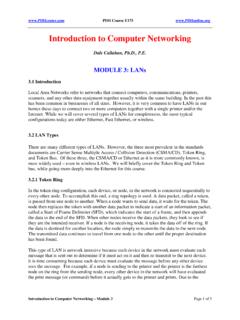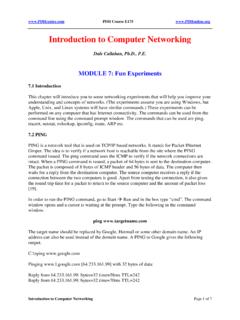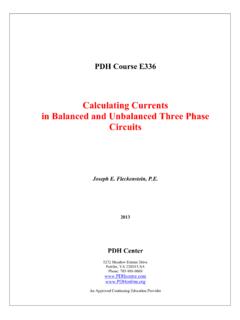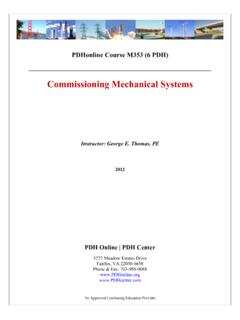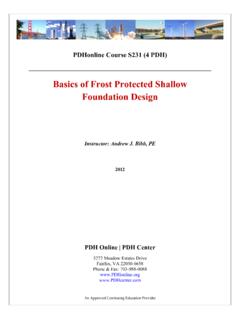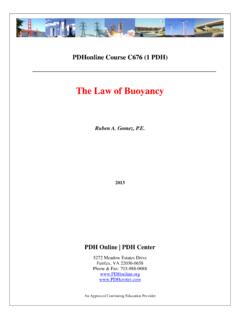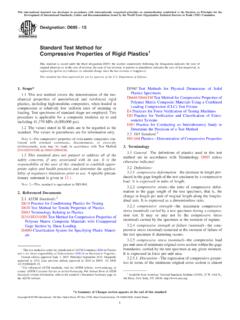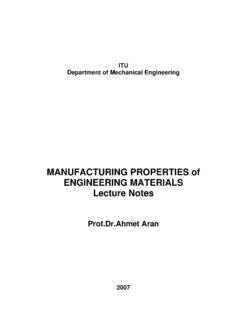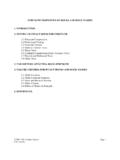Transcription of Laboratory Testing and Interpretation of Rock Properties
1 PDHonline Course C264 (4 PDH) Laboratory Testing and Interpretationof Rock Properties2012 Instructor: John Poullain, PEPDH Online | PDH Center5272 Meadow Estates DriveFairfax, VA 22030-6658 Phone & Fax: Approved Continuing Education Provider8 - 1 CHAPTER Testing FOR rock Testing is performed to determine the strength and elastic Properties of intact specimens andthe potential for degradation and disintegration of the rock material. The derived parameters are used inpart for the design of rock fills, cut slopes, shallow and deep foundations, tunnels, and the assessment ofshore protection materials (rip-rap). Deformation and strength Properties of intact specimens aid inevaluating the larger-scale rock mass that is significantly controlled by joints, fissures, and discontinuityfeatures (spacing, roughness, orientation, infilling), water pressures, and ambient geostatic stress TESTSC ommon Laboratory tests for intact rocks include measurements of strength (point load index, compressivestrength, Brazilian test, direct shear), stiffness (ultrasonics, elastic modulus), and durability (slaking,abrasion).
2 Table 8-1 gives a summary list of Laboratory rock tests and procedures by ASTM. Brief sectionsdiscuss the common tests (denoted with an asterisk*) useful for a standard highway project involvingconstruction in TestsThe Laboratory determination of intact rock strength is accomplished by the following tests: point loadindex, unconfined compression, triaxial compression, Brazilian test, and direct shear. The uniaxial (orunconfined) compression test provides the general reference value, having a respective analogy withstandard tests on concrete cylinders. The uniaxial compressive strength (qu = Fu) is obtained by compressinga trimmed cylindrical specimen in the longitudinal direction and taking the maximum measured forcedivided by the cross-sectional area.
3 The point load index serves as a surrogate for the UCS and is a simplertest in that irregular pieces of rock core can be used. A direct tensile test requires special end preparationthat is difficult for most commercial labs, therefore tensile strength is more often evaluated by compressionloading of cylindrical specimens across their diameter (known as the Brazilian test). Direct shear tests areused to investigate frictional characteristics along rock discontinuity 8-1: (a) Intact Rock Specimens for Laboratory Testing ; (b) compressive Strength - 2 TABLE & PROCEDURES FOR Laboratory Testing OF INTACT ROCKTestCategoryName of TestTest DesignationAASHTOASTMP oint LoadStrengthMethod for determining point load index (Is)-D 5731*CompressiveStrengthCompressive strength (qu = Fu) of core in unconfinedcompression (uniaxial compression test)
4 -D 2938*Triaxial compressive strength without pore pressureT 226D 2664 CreepTestsCreep-cylindrical hard rock core in uniaxial compression -D 4341 Creep-cylindrical soft rock core in uniaxial compression-D 4405 Creep-cylindrical hard rock core, in triaxial compression -D 4406 TensileStrengthDirect tensile strength of intact rock core specimens-D 3936 Splitting tensile strength of intact core (Brazilian test)-D 3967*Direct ShearLaboratory direct shear strength tests - rock specimens,under constant normal stress-D 5607*PermeabilityPermeability of rocks by flowing air-D 4525 DurabilitySlake durability of shales and similar weak rocks -D 4644*Rock slab Testing for riprap soundness.
5 Usingsodium/magnesium sulfate -D 5240*Rock-durability for erosion control under freezing/thawing-D 5312*Rock-durability for erosion control under wetting/drying -D 5313 Deformationand StiffnessElastic moduli of intact rock core in uniaxial compression -D 3148*Elastic moduli of intact rock core in triaxial compression -D 5407 Pulse velocities and ultrasonic elastic constants in rock-D 2845*SpecimenPreparationRock core specimen preparation-D 4543 Rock slab preparation for durability Testing -D 5121 Note: *Routine rock test procedure described in this manual8 - 3 Point Load Index (Strength)ASTMD 5731 PurposeTo determine strength classification of rock materials through an index specimens in the form of core (diametral and axial), cut blocks or irregular lumpsare broken by application of concentrated load through a pair of spherically truncated,conical platens.
6 The distance between specimen-platen contact points is recorded. Theload is steadily increased, and the failure load is is little sample preparation. However, specimens should conform to the size andshape requirements as specified by ASTM. In general, for the diametral test, corespecimens with a length-to-diameter ratio of are adequate while for the axial testcore specimens with length-to-diameter ratio of to are suitable. Specimens forthe block and the irregular lump test should have a length of 50 35 mm and adepth/width ratio between and (preferably close to ). The test specimens aretypically tested at their natural water corrections are applied to obtain the point load strength index, Is(50), of a rockspecimen.
7 A strength anisotropy index, Ia(50), is determined when Is(50) values aremeasured perpendicular and parallel to planes of test can be performed in the field with portable equipment or in the Laboratory (Figure 8-1). The point load index is used to evaluate the uniaxial compressivestrength (Fu). On the average, Fu . 25 Is(50). However, the coefficient term can varyfrom 15 to 50 depending upon the specific rock formation, especially for anisotropicrocks. The test should not be used for weak rocks where Fu < 25 8-1: Point Load Test Apparatus. (Adopted from Roctest)8 - 4 u =Uniaxial Compression TestAASHTOASTM -D 2938 PurposeTo determine the uniaxial compressive strength of rock (qu = Fu = FC).
8 ProcedureIn this test, cylindrical rock specimens are tested in compression without lateralconfinement. The test procedure is similar to the unconfined compression test for soilsand concrete. The test specimen should be a rock cylinder of length-to-width ratio (H/D)in the range of 2 to with flat, smooth, and parallel ends cut perpendicular to thecylinder axis. Originally, specimen diameters of NX size were used (D = 2c in. = 44mm), yet now the standard size is NQ core (D = 1f in. = mm). (a)(b)Figure 8-2:Uniaxial Compression Test on Rock with (a) Definitions of stressconditions and strains, (b) Derived stress-strain curve with peakstress corresponding to the uniaxial compressive strength (qu = Fu)CommentaryThe uniaxial compression test is most direct means of determining rock strength.
9 Theresults are influenced by the moisture content of the specimens, and thus should benoted. The rate of loading and the condition of the two ends of the rock will also affectthe final results. Ends should be planar and parallel per ASTM D 4543. The rate ofloading should be constant as per the ASTM test procedure. Inclined fissures, intrusions,and other anomalies will often cause premature failures on those planes. These shouldbe noted so that, where appropriate, other tests such as triaxial or direct shear tests canbe - 5 Splitting Tensile (Brazilian) Test for Intact RocksAASHTOASTM None D 3967 PurposeTo evaluate the (indirect) tensile shear of intact rock core, specimens with length-to-diameter ratios (L/D) of between 2 to are placed ina compression loading machine with the load platens situated diametrically across thespecimen.
10 The maximum load (P) to fracture the specimen is recorded and used tocalculate the split tensile strength. Figure 8-3. Setup for Brazilian Tensile Test in Standard Loading Brazilian or split-tensile strength (FT) is significantly more convenient andpracticable for routine measurements than the direct tensile strength test (T0). The testgives very similar results to those from direct tension (Jaeger & Cook, 1976). It is amore fundamental strength measurement of the rock material, as this corresponds toa more likely failure mode in many situations than compression. Also, note that thepoint load index is actually a type of Brazilian tensile strength, that is correlated backto compressive strength.
